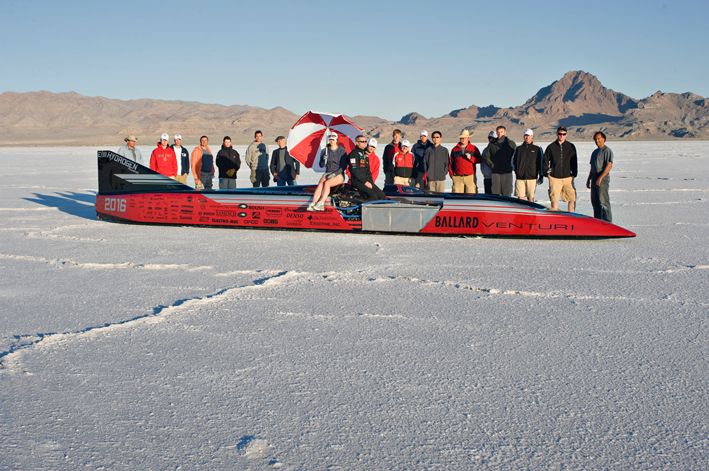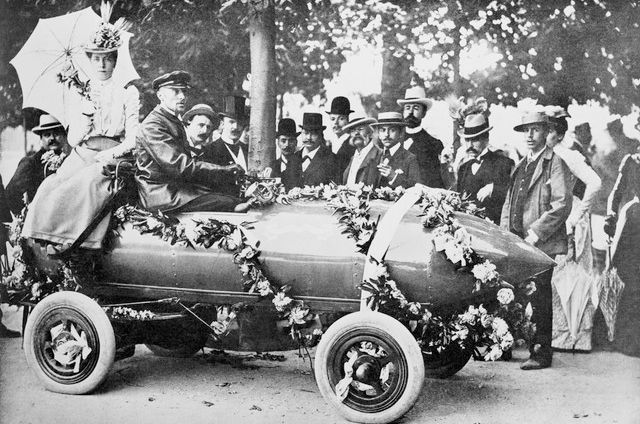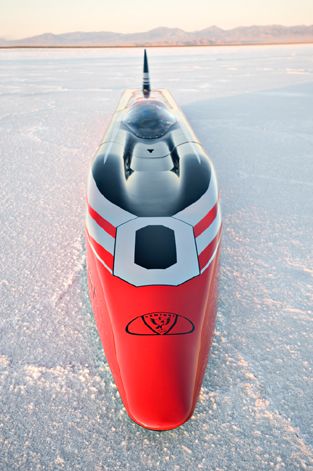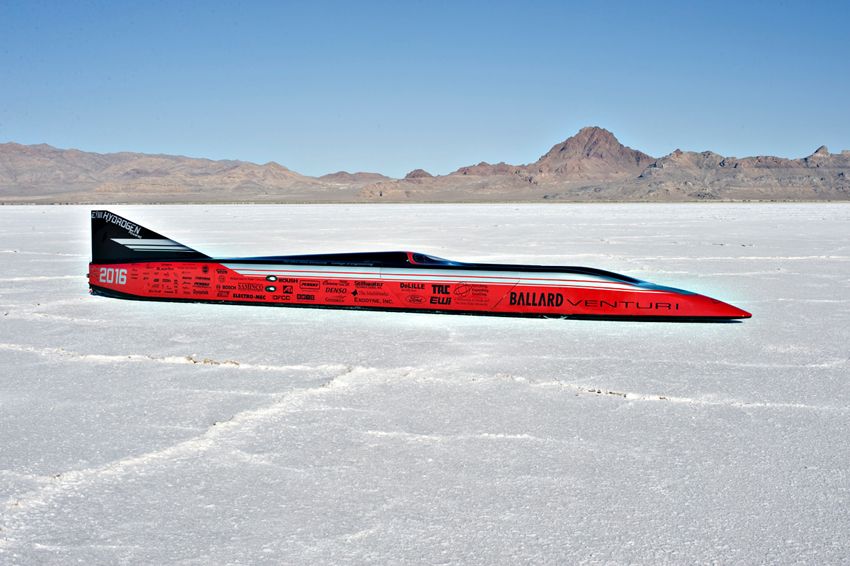Setting land speed records for an alternatively powered vehicle, the Venturi Buckeye Bullet, the world's first hydrogen fuel cell powered high speed streamliner to break the 300 MPH mark. Nicknamed "La Jamais Contente", 750 HP was developed in partnership with the students at Ohio State University and pays tribute to the original record setting electric racer of the same name from back in 1899 when the antique automobile become the first vehicle to achieve 60 MPH. The project is part of a 3 year program with the University during which time the Streamliner will attempt to break a few other records for electrically propelled race cars as well as with the further development of innovations in driver safety, driveline, electronics and packaging for the high speed application.
After the team's success back on September 25 with back to back 300 MPH passes down the mile long stretch of salt, the team's efforts will continue on into the 2010 and 2011 land speed record seasons. To be exact, the Buckeye Bullet 2 currently holds both national and international land speed records of 315 MPH and 272 MPH as well as the honor of being the first zero emissions electric vehicle to run at over 300 MPH.
Just like the original "Jamais Contente," the Buckeye Bullet 2 shows that electricity is a very powerful fuel and with the right configuration shows that anything is possible. This is also a powerful push for future EVs like the upcoming Chevrolet Volt->ke2721, demonstrating that electricity can be a functional fuel. The Team made up of Ohio State students and staff isn't done yet, their next goal is to reach 350 MPH in the battery powered streamliner.
Full specifications after the jump.
venturi-buckeye-bullet
- Make: Array
- Model: venturi-buckeye-bullet
2009 Venturi Buckeye Bullet
- [do not use] Vehicle Model: Array
SPECIFICATIONS
Overview
- Next generation of Landspeed Racing
- Worlds first hydrogen fuel cell streamliner
- Designed and built by engineering students at The Ohio State University
- Currently set to run in Bonneville’s EIII Class at Speedweek 2009
- Driven by a custom 700+ HP electric motor
- Fueled by onboard Hydrogen and Oxygen
- Designed for safety from the ground up
- 50+ channel data acquisition system, wireless telemetry, and GPS locating system
- Test bed for research in many numerous areas
Chassis
- Designed using Solidworks CAD software to reduce mass and increase torsional stiffness
- Optimized using FEA software
- Removable cross bracing across fuel cell modules and fuel tanks for service
-
4130 Chromolly steel
- Many other materials and composites were analyzed and designed.
- The mechanical properties, flexibility in joining, resilience, fixture design, and reparability on the salt all lead to its’ selection
- Range of cross sections (square, rectangular, round)
- Range of thicknesses (0.049”- 0.095”)
Aerodynamics
-
Requirements & Considerations
- Low drag
- Low pitch sensitivity
- Lateral/crosswind stability
- ppropriate down force
-
CFD
- Computatinoal Fluid Dynamics: the use of numerical methods and algorithms to solve the Navier-Stokes equations, which define single-phase fluid flow, on discritized geometry
- CFD provides a virtual wind tunnel: body shapes can be aerodynamically simulated without manufacturing physical prototypes, design changes can be evaluated quickly, accurately, and economically
- Models solved in parallel on 12 processors
-
Wind tunnel
- Critical for CFD validation
- 1/3 scale model
- Open test section wind tunnel
- 64 static pressure measurements for CFD correlation
Body
- Designed using Solidworks CAD software and optimized using CFD and windtunnel testing
- Carbon fiber skin
- Nomex honeycomb to increase stiffness and strength and reduce weight
- CNC machined molds for ultimate accuracy
- Multiple quick release panels to allow for easy access maintenance
- Interchangeable fin section to allow for future changes to vertical surface area.
Driveline
- Custom machined solid aluminum wheels and high speed Bonneville racing tires
- Semi-custom 6 speed transaxle (Transmission and Differential unit)
-
Electrical Traction System
- Custom built AC Induction Motor
- 3 Phase
- Lightweight design
- 700+ Horse Power
- High efficiency
-
Motor Controller
- Converts DC electricity to 3 phase AC to drive the motor
- Very high efficiency
Safety
Driver tub
- Increase stiffness around driver
- Provide impact/ intrusion resistant wall between vehicle and driver
- Eliminate sharp edges and seems around driver
-
Prepreg carbon fiber/ aluminum honeycomb composite tube
- Six (three on either side) layer 3K carbon fiber and,
- half inch aluminum honeycomb sandwich
-
Integrated driver restraint points
- Additional plys of carbon at driver restraint points
- distributes loads
- Integrated molded beaded seat
- Mechanically fastened to chassis
Fuel Cell System (Power Plant)
- Combines onboard Hydrogen & Oxygen to create electricity
- Not all chemical energy can be transformed in to electricity (About 60-80%)
- By-products are heat & water
- The cells heat up just like and engine and need to be cooled
- A radiator would cause to much drag traveling at 300 mph, so a ice bath was chosen an the cooling strategy
Data Acquisition
- State-of-the-art Bosch Motorsport data acquisition system
- Fully integrated double-layer CAN communication system
- High range wireless telemetry for real-time monitoring of vehicle systems
- On-board diagnostics for real-time driver feedback
- High accuracy GPS-based position and speed logging
- Over 50 channels of data





